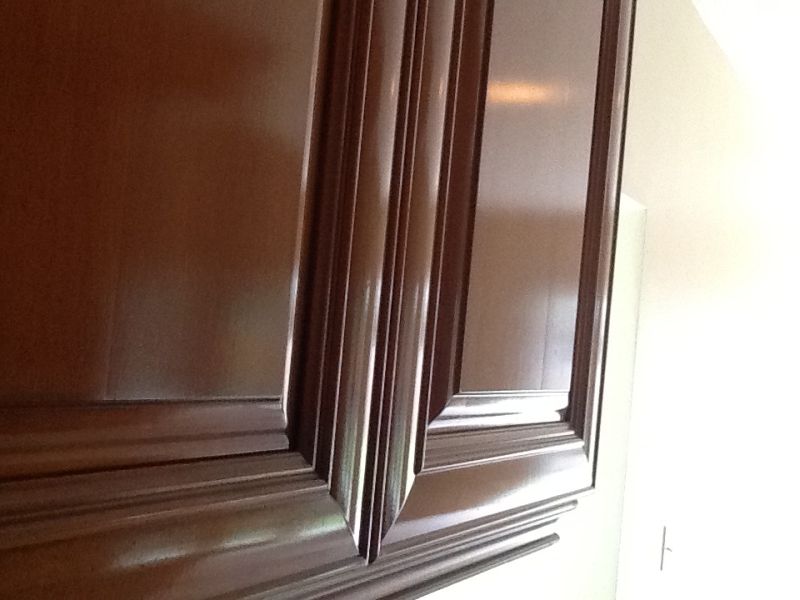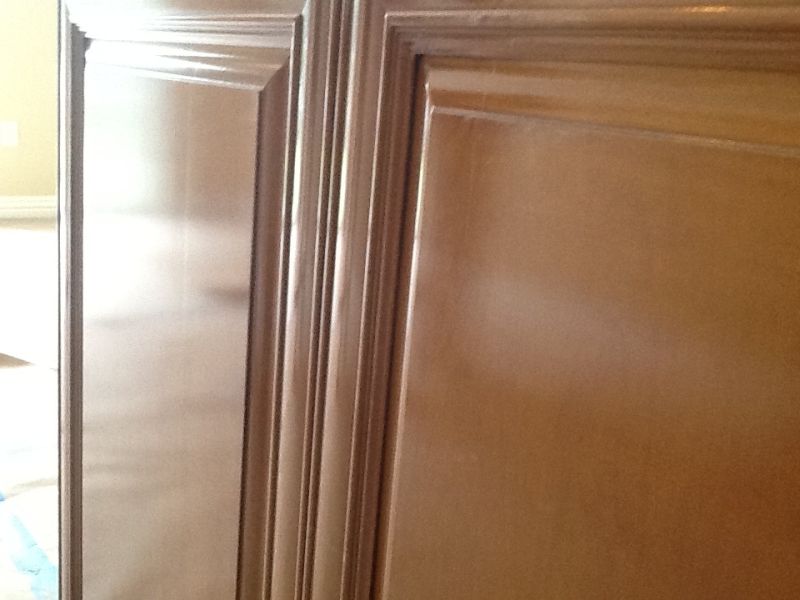Sunken Joints at the Glue Seam
Here's a good explanation of why glue seams in cabinet doors may appear visibly depressed. April 29, 2013
Question
What most likely caused the raised panels on these cabinet doors to have the glue seams so visible, showing sunken joints? Could it be the finisher?

Click here for higher quality, full size image

Click here for higher quality, full size image
Forum Responses
(Finishing Forum)
From contributor D:
When doors are glued up at the factory, the panel parts are put together with waterbase glue, usually PVA. After a short while, say 30 minutes to an hour, the panels are put through the planers and sanders. Of course the water in the glue line tends to swell the wood slightly and that swollen glue line is then surfaced before the wood dries back to the moisture content of the raw stock. After a few days, the wood will have shrunk back to normal moisture balance, leaving the effect you see in the pictures you have posted. An unfortunate side effect of our need to have doors produced faster and cheaper.
From contributor R:
It wasn't the finisher, it was the guy who made the doors. Too much glue. The moisture in the glue swelled the wood at the joint. It was sanded flush before finishing but then as the wood aged it shrank back as the wood reached a normal moisture content and it pulled in the joint.
From contributor L:
Yep, agreed. When I make doors I glue up the panels and then wait a couple of days before planing and sanding. The other thing I might do if I push things a bit is do the glue up, plane, and run through the widebelt. Usually at this point the panels have dried overnight. Then I deal with another aspect of the job for a day or two, then I RO sand the panels, paying attention to the joints. You can take care of a lot of it if you are a patient finisher. Lots of extra sanding to make sure you have a dead flat finish. But usually in the end you will have sunken joints.
From contributor S:
I see way more problems than just the glue lines. The finisher may have sanded the panel face a little, but what about all of the other rough spots? Like anything, quality is in the finish no matter what. This paint was rushed no matter how you look at it. The flats could have been sanded dead flat very easy. The first cut on a primed surface shows you all the flaws. It is how you deal with what see gives the best results. You either keep cutting or you say, ugh - they'll never see that. The best finishes take time. Prime first coat, let sit for a few days so the solvents evaporate and primer shrinks, sand first coat, prime and let second sit for 2-5 days. All the way around letting the primer cure properly and then sanding properly can produce perfect results. Primer is not a sealer; it is applied to flatten and shape.
From contributor L:
Modern primers will shrink back enough overnight. But there are no primers there, it's stain and clear. If it gets rushed and you are finishing the door in 3 hours, then things are going to shrink back and you will see things telegraph. But this looks more to do with the wood being processed too quickly, before the water from the glue could escape the panel.
From contributor Z:
If I had to wait more than a day, I'd be screwed. My finish comes out like butter but it's not water based - it's MLC Resistant or Durovar.
From contributor S:
Duravar is nice. The only bad thing is your customer can't breath for about 30 months after you install your work because the stuff off gases for years. We installed a kitchen that was finished with it and it was absolutely gorgeous, but it was very hard for the customer to live with the smell that was heavy for months and lingered for many more.

